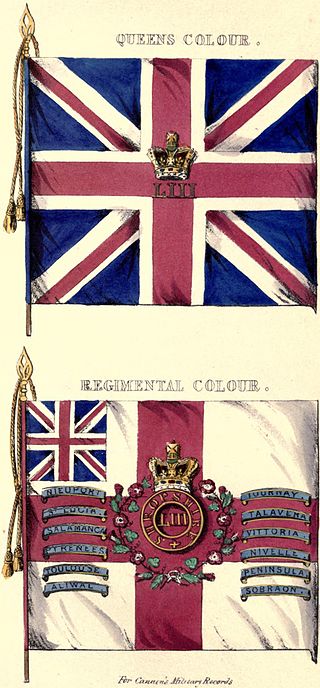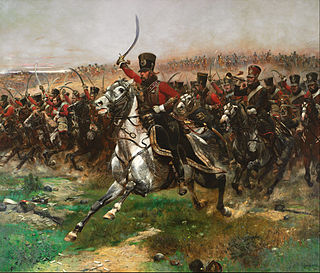Related Research Articles

The French Revolutionary Army was the French land force that fought the French Revolutionary Wars from 1792 to 1802. In the beginning, the French armies were characterised by their revolutionary fervour, their poor equipment and their great numbers. However, the French Revolutionary Army had become arguably the most powerful army in the world by the mid-1790s, as the French armies had become well-experienced and organized, enabling them to comfortably outfight their enemies.

The 53rd (Shropshire) Regiment of Foot was a British Army regiment, raised in 1755. Under the Childers Reforms it amalgamated with the 85th Regiment of Foot to form the King's Shropshire Light Infantry in 1881.

The 73rd Regiment of Foot was an infantry regiment of the British Army, raised in 1780. Under the Childers Reforms it amalgamated with the 42nd Regiment of Foot to form the Black Watch in 1881.

The 55th Regiment of Foot was a British Army infantry regiment, raised in 1755. After 1782 it had a county designation added, becoming known as the 55th (Westmorland) Regiment of Foot. Under the Childers Reforms it amalgamated with the 34th (Cumberland) Regiment of Foot to form the Border Regiment in 1881.
The 69th Regiment of Foot was an infantry regiment of the British Army, raised in 1756. Under the Childers Reforms it amalgamated with the 41st (Welch) Regiment of Foot to form the Welch Regiment in 1881.
The 130th Regiment of Foot was an infantry regiment of the British Army, created in 1794. After being raised it was sent to the West Indies, where it suffered heavy losses from tropical disease. The unit was disbanded at Santo Domingo in 1796, with the survivors drafted into other regiments.
The 112th Regiment of Foot was an infantry regiment of the British Army from 1794 to 1795. It was raised in July 1794 and stationed in Ireland.
The 109th (Aberdeenshire) Regiment of Foot was an infantry regiment of the British Army from 1794 to 1795. Raised by Alexander Leith Hay for service in the French Revolutionary Wars the regiment was briefly deployed in Jersey before it was disbanded in England and its men sent to reinforce the 53rd (Shropshire) Regiment of Foot. The disbandment was controversial as Leith-Hay believed it contravened an assurance given to him in his original letter of service to raise the regiment.
The 107th Regiment of Foot was a short-lived infantry regiment of the British Army formed during the French Revolutionary Wars.

Gerhard Ritter von Rosselmini or Gherardo Rosselmini or Gerhard Roselmini became a general officer in the Austrian army during the French Revolutionary Wars and fought in several actions against Napoleon Bonaparte's French army during the 1796 Italian campaign. From 1789 to 1794 he commanded an Austrian infantry regiment. He led the unit in several battles on the upper Rhine in 1793 before being captured. He was promoted to General Major in early 1794. Rosselmini died in Italy while on campaign.

The Invasion of Guadeloupe was a British attempt in 1794 to take and hold the island of Guadeloupe in the French West Indies during the French Revolutionary Wars. The British had negotiated with the French planters, Ignace-Joseph-Philippe de Perpignan and Louis de Curt, who wished to gain British protection, as France's National Convention was passing a law abolishing slavery on 4 February 1794. The Whitehall Accord was signed on 19 February 1794 while the British were securing Martinique in the Battle of Martinique (1794).

The 4th Hussar Regiment is a hussar regiment in the French Army, raised and embodied in 1783 and still in existence.
The 102nd Regiment of Foot was a short-lived regiment of the British Army raised in 1793 and disbanded in 1795.
The 9th Light Infantry Regiment was a French army regiment. One of the most notable infantry regiments in the Napoleonic Wars, it was awarded the title "Incomparable" by Napoleon Bonaparte after their brilliant performance at the Battle of Marengo on 14 June 1800. The regiment went on to serve with distinction in the Ulm Campaign, at the Battle of Dürenstein, the Jena Campaign (1806), and the Battle of Friedland. The regiment then served in the Peninsular War taking a notable role at the Battle of Talavera 27–28 July 1809 and the Siege of Badajoz (1812). Battalions from the regiment also fought on the Wagram Campaign (1809), at the Battle of Leipzig, and Napoleon's campaigns in France (1814). During the Hundred Days the 9th Light fought at Battle of Ligny and the Battle of Wavre. The regiment was disbanded in the aftermath of the Bourbon Restoration.
The 99th Regiment of Foot was an infantry regiment of the British Army, raised on 10 February 1794 by Lieutenant-Colonel Stuart Douglas and numbered as the 99th Foot in October of the same year.
The 105th Regiment of Foot had a brief existence as a British Army infantry regiment between 1794 and 1795. Its Regimental Colonel throughout its brief history was Colonel Gordon Forbes.

The Hompesch Hussars was a German light cavalry regiment of the French Armée des Émigrés raised by the Freiherr von Hompesch. The regiment was raised in 1794 following an expansion of the British foreign corps, and served in the Flanders campaign, notably at the Battle of Boxtel. However, following the unsuccessful attempt to overthrow the Republican government, the regiment was deployed to the West Indies instead of a planned deployment to Western France. They were slowly destroyed in the West Indies by disease and fever and finally disbanded in October 1797.
Lieutenant-General Sir William Myers, 1st Baronet was a British soldier, born in Whitehaven. His father was Christopher Myers of Monkstown, County Dublin [formerly of Whitehaven] who was the architect of the Chapel of Trinity College Dublin. His mother was Jean Graham, cousin to the 3rd Duke of Montrose.
The Royal Manchester Volunteers was established in 1794 and on 1 April 1794 it was taken on to the establishment of the British Army as the 104th Regiment of Foot. On 21 August 1794 General Musgrave inspected the regiment. The regiment received its colours in St Anne's Square, after which it marched to Liverpool to embark for Ireland.
References
- ↑ "British Regiments and the Men Who Led Them 1793–1815: the "Ephemeral Corps" 1793–1796". www.napoleon-series.org. Retrieved 9 June 2019.
- ↑ Perry 2005, p. 72.